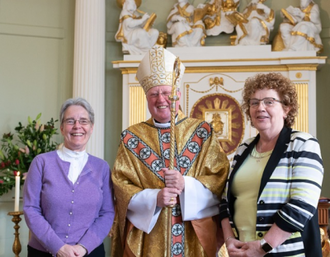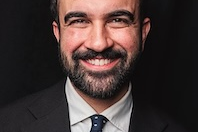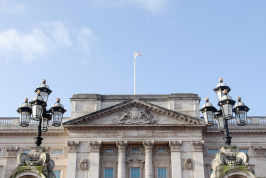York: Celebration marks 250th anniversary of Bar Convent Chapel

Sr Jane Livesey CJ and Sr Noelle Corscadden IBVM with Bishop Drainey
It is not often that bishops and other dignitaries gather to celebrate a group of people breaking the law.
But Bishops Terry Drainey of Middlesbrough and John Crowley, his predecessor, together with bishop Glynn Webster, Anglican Bishop of Beverley, came to the Bar Convent in York on April 27th with visitors from across Britain, Ireland, Europe and Africa to celebrate the 250th anniversary of the opening of a Catholic chapel in the Bar Convent, York, when England was still living under anti-Catholic Penal Laws.
The general superiors of both branches of Mary Ward's sisters, Sister Jane Livesey CJ and Sister Noelle Corscadden IBVM travelled from Rome for the anniversary Mass which was also attended by the provincial leaders of the respective congregations in Britain, Sisters Bernadette Boland IBVM and Frances Orchard CJ.
Sisters were present from Kenya, Zimbabwe and Spain as well as from Ireland and across Britain. Recalling Mary Ward's early years as a Poor Clare Nun, Mother Bernard Littlefair, former Abbess of the Poor Clare monastery of York and an alumna of the Bar Convent Grammar School was in attendance, together with Dame Andrea Savage, abbess of Stanbrook Abbey.
The Bar Convent is Britain's oldest living convent. Founded by the followers of Ven Mary Ward (1585-1645), who modelled her order on the Society of Jesus, it has housed sisters and a school since 1686. Nine years before the First Catholic Repeal Act was passed in 1778, allowing Catholics to own property and inherit land, Mother Ann Aspinal determined to build a chapel both for the sisters' own worship and for the use of neighbouring Catholics in York. York architect Thomas Atkinson designed a domed chapel which had to be hidden beneath the outer roof of the building to shield the sisters from the religious turbulence of the period. He also designed the chapel to have eight separate exits and a priest's hiding hole in order to allow for the swift escape of the priest and congregation in the event of a raid by the authorities. The magnificent altar depicts four doctors of the church and the emblem of the pelican feeding its young from its wounded breast. The emblem is repeated in a vestment which is thought to have been worn at the first Mass. Local donors, including many of the sisters' neighbours, raised the equivalent of £78,000 to fund the building work.
Not all neighbours were supportive, however, and Mother Aspinall wrote: 'There are many persons who have expressed dissatisfaction about our building. They are very curious to know whether we are nuns or not, believing if we are we ought not to remain here. They suspect our house is a convent'.
Despite this opposition the first Mass was celebrated in the chapel on April 27th 1769 by the chaplain, Fr Joseph Robinson SJ. The Jesuit connection with the chapel was marked at the anniversary by the presence of Fr Philip Endean SJ, who concelebrated the Mass with clergy from the diocese.
After the various Catholic Relief Acts the sisters were permitted to wear their religious habit for the first time since the foundation of the convent and to run a school openly. The convent was eventually granted a licence to act as a public place of worship. The most precious relic held in the chapel is the hand of St Margaret Clitherow, a York butcher's wife pressed to death for sheltering priests in 1586. One of those priests was Mary Ward's cousin, Bl Francis Ingleby, hanged, drawn and quartered on the Knavesmire at York in the same year.
The Bar Convent became the birthplace of another branch of Mary Ward's congregation, the Institute of the Blessed Virgin Mary, or Loreto sisters, founded in Ireland by Frances Teresa Ball in 1821. Ven Mary Aikenhead, founder of the Irish Sisters of Charity, also made her novitiate at the Bar Convent before starting her first convent in Dublin in 1815.
Read more about the Bar Convent here: www.bar-convent.org.uk/


















